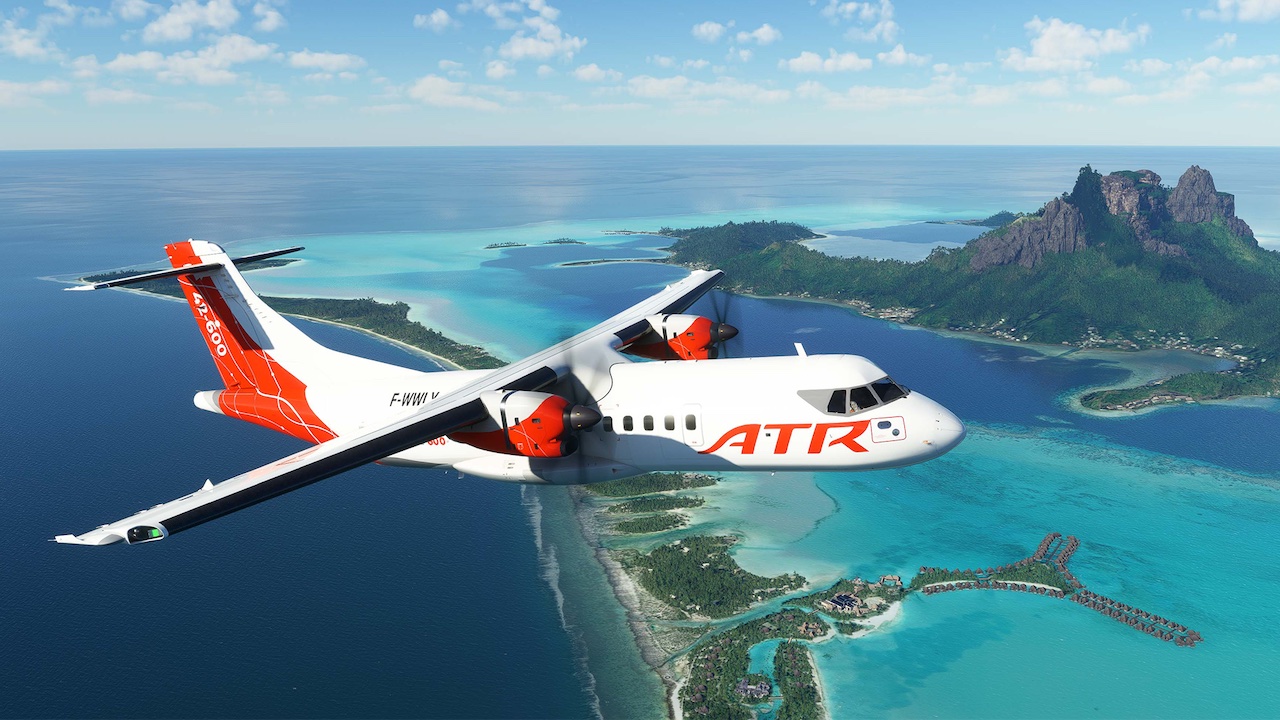Install by extracting into your MSFS 2020 Community folder and then follow the “microsoft-aircraft-atr\README.txt”! Please follow the installation procedure again even if you used previous versions of this aircraft.
– Fixed ATR 72-600F pulling to the right
– Fixed propeller animation for ATR 72-600F
– Known Issue: the propeller animation for the ATR 42-600S has not yet been fixed
– Fixed ATR 42-600 Highline not producing enough power for takeoff
– Fixed Battery lock reversed tooltip state
– Fixed EFB loading for 72-600 Freighter
– Fixed power cut in CRZ mode in 42-600 Standard
v1.0.46:
– Added two new ATR type variants:
– ATR 42-600S (STOL)
– ATR 72-600F (Freighter)
– Fixed an issue with gear not fully extended when hydraulics is lost (prop ftr) after a landing.
– Added new runway threshold calculation (SU15+).
– Changed VNAV Path following to higher precision.
– Fixed ACW buses supply logic with ACW Ext Pwr and BTC Off.
– Fixed TAT warnings logic on ground.
– Fixed V-FP arming logic.
– VCP MOVE menu is now usable in MFD ND PLAN mode.
– Fixed VOR/BC/APP mode not activating when off-side nav source is used.
– Added marker for MAX throttle position to calibration window.
– EFB Options items re-arranged.
– Fixed in issue that caused trans alt and TO data confirm input to be constantly overwritten after a landing.
– Fixed TGT IAS showing -1 on VNAV page.
– Fixed maximum FD pitch command in IAS mode to 15 degrees.
– Fixed a bug in CRZ IAS calculation.
– Fixed a GPWS inhibit issue.
– Added functions to correct fuel flow in idle, feathered and hotel mode.
– Added aircraft.cfg and loc entries for 42-600S, 72-600F and new Highline versions.
– Changed flight_model.cfg payload entries for ATR 72-600F model (Fedex version).
– Added freighter support to EFB.
– Fixed EWD prev/next page arrows in EWD sometimes displayed wrong.
– Added additional Highline variants to ATR 42-600 and ATR 72-600
– Added payload support for Highline 03 variants.
– Update electronic checklists to v37
– Art fixes
The ATR 42-600
The 42-600 is a twin-engine commuter airliner with a high-wing turboprop, that can seat up to 50 passengers. It took its first flight in March of 2010 and was introduced into service in late 2012. Distinctive in appearance with elegant lines and curves, it boasts thoroughbred performance in the air and can operate out of a wide variety of airfields.
The 42-600 is an advanced iteration of the ATR 42, a family of regional airliners first conceived in the early 1980s. Named “42” due to the number of seats of the original version, the aircraft was designed to be a highly efficient airframe optimized for commuter lines.
The 42-600, operated by a flight crew of two, features an advanced glass cockpit, spacious cabin, and improved efficiency and performance over its predecessors. The aircraft measures 74 feet, 5 inches in length and stands 24 feet, 11 inches tall. It features a high-aspect ratio main wing with a span of 80 feet, 7 inches and a T-tail empennage. It is powered by two Pratt & Whitney Canada PW127XT-M engines, each delivering 2,400 horsepower to a 6-blade propeller.
The 42-600, while not designated a STOL (short take-off and landing) aircraft, has excellent short field and high-density altitude performance, with a take-off run of 3,631 feet at sea level, fully loaded. It has a range of 835 miles and a cruising speed of 345 miles per hour.
The ATR 42-600 comes with three liveries:
• ATR House Livery F-WWLY
• Air Saint Pierre F-ORLB
• Silver Airways N405SV
The ATR 72-600
The 72-600 is a refined, and the most notable, version of the ATR 72, which is a stretched variant of the company’s ATR 42 family of aircraft. The airframe boasts improved cabin design and an advanced multi-panel glass cockpit to optimize pilot efficiency. The ATR 72-600 allows aviators to sharpen their skills and push their abilities to new heights as they cruise the airways around the globe.
The ATR 72-600 is a high-wing, twin-turboprop, regional airliner that took its maiden flight on July 24, 2009, and was introduced into service in 2010. The ATR 72-600 is crewed by two and can carry up to 78 passengers, although its standard configuration is only 70 seats. While primarily serving as a passenger carrier, the 72-600 has also been used by various countries’ militaries for maritime patrol and logistical support.
While designed for and used as a short-haul carrier, the ATR 72-600’s form projects a tone of sportiness and performance. It features a long, sleek fuselage, a T-tail empennage, and has a high-aspect ratio main wing with a slight leading edge sweep. The wingspan measures 88 feet, 9 inches.
The 72-600 is powered by two Pratt & Whitney Canada PW127XT-M turboprop engines that each deliver 2,750 horsepower to 6-blade Hamilton Standard propellers. The ATR 72-600 has a range of 850 miles, a service ceiling of 25,000 feet above sea level, and a cruise speed of 320 miles per hour.
The ATR 72-600 comes with five liveries:
• ATR House Livery F-WWEY
• Silver Airways N703SV
• Air Tahiti “RA’IREVA” F-ORVV
• Air Tahiti “TAPUATA” F-ORVR
• Air Tahiti “TE ANUANUA” F-ORVT

